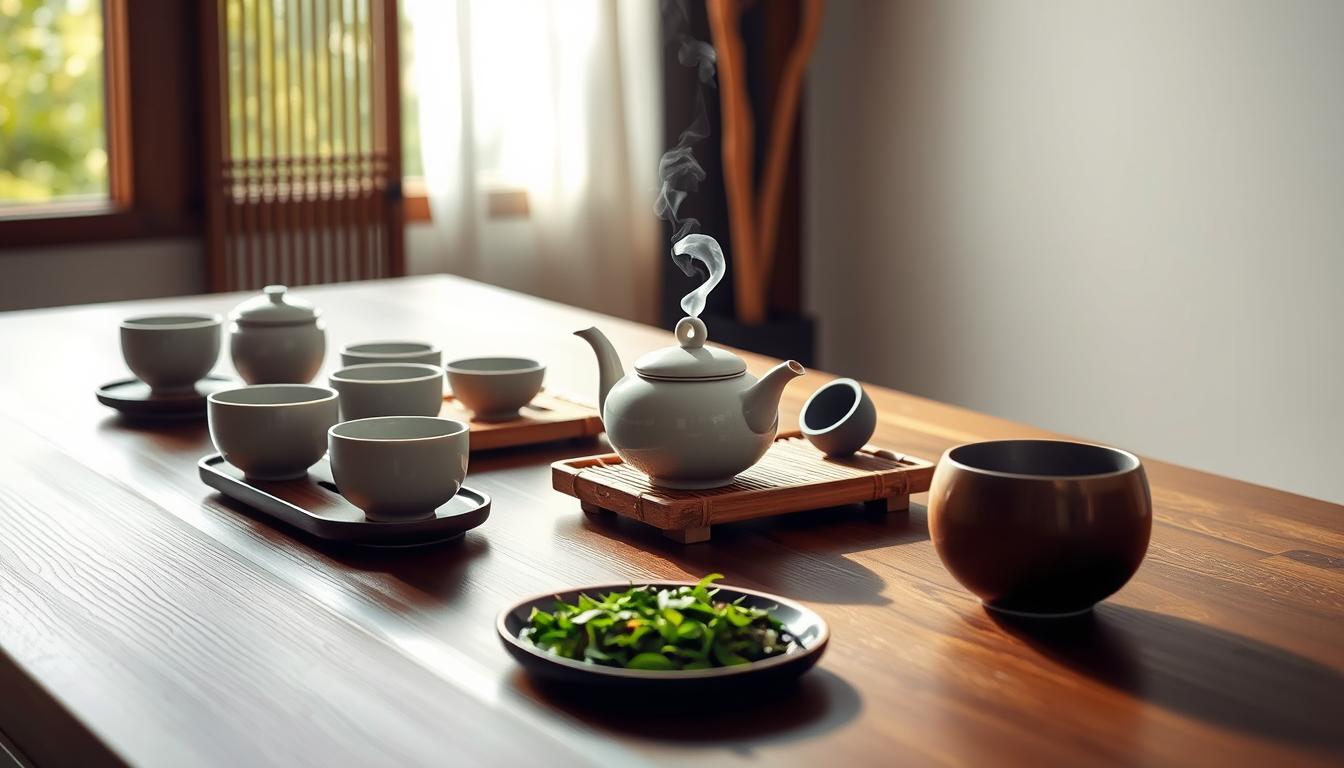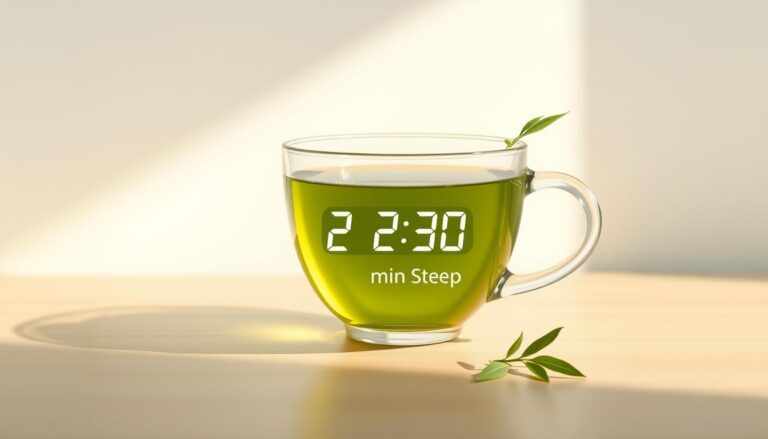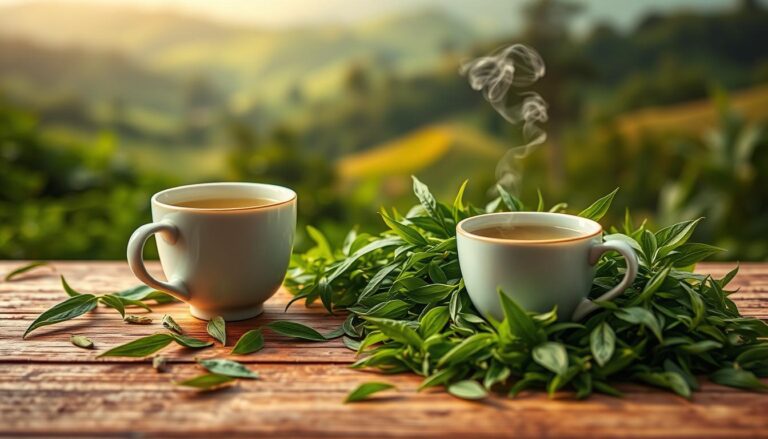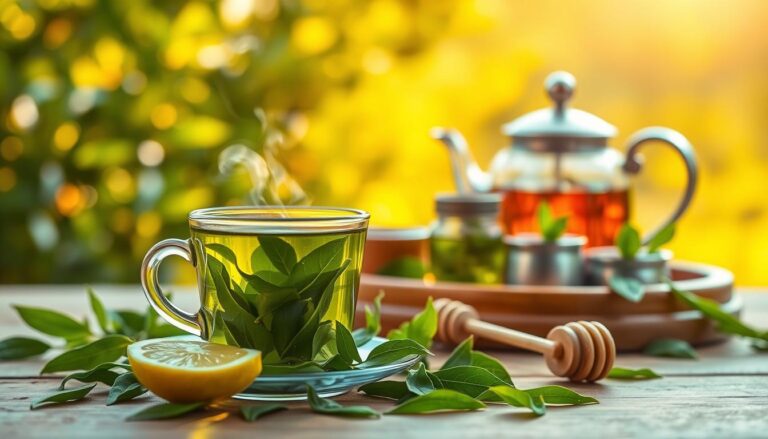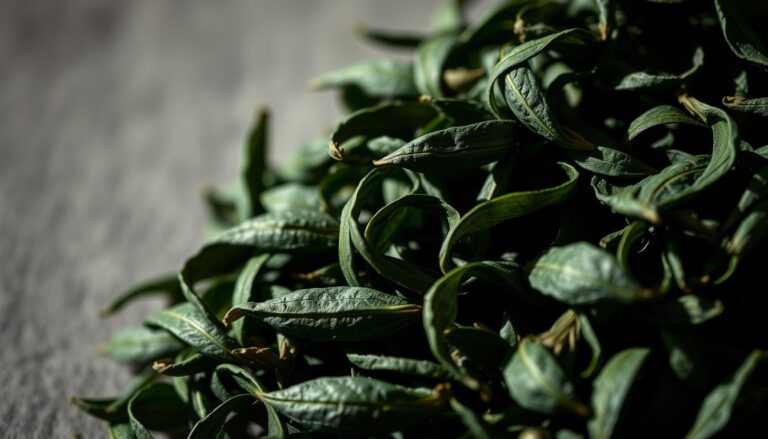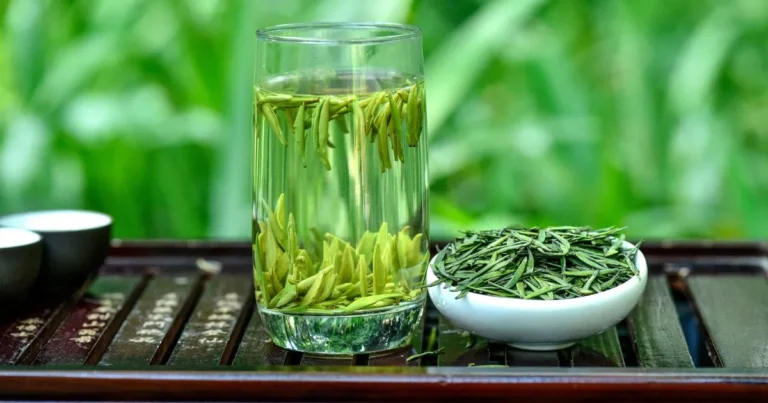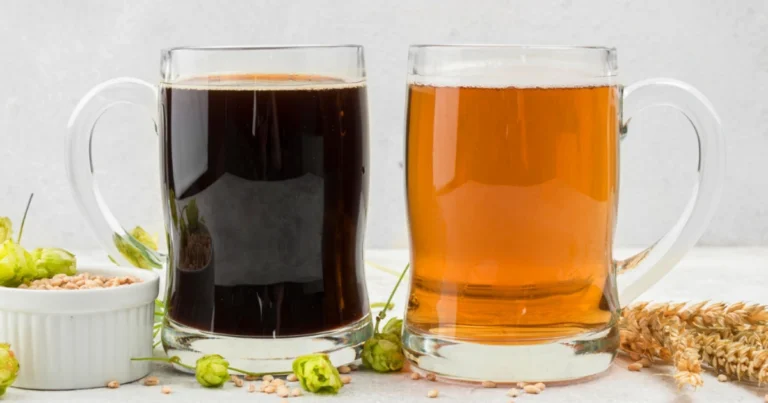How To Make Green Tea at Home:7 Easy Steps
Each morning, I embraced a simple ritual that transformed my life: making the perfect cup of green tea. For me, tea is more than just a beverage it’s a moment of calm, a connection to tradition, and a peaceful way to start the day.
Learning how to make green tea isn’t only about preparing a drink. It’s about engaging in a timeless practice that ties you to generations of wisdom and mindfulness. Whether you’re a tea enthusiast or just beginning, this ritual can bring a special rhythm to your day.
Originating from China and Japan, green tea offers more than just refreshment. It’s a gateway to better health, mental clarity, and serenity in a fast-paced world. With just tea leaves and hot water, you can unlock a world of flavor and well-being.
Table of Contents
Key Takeaways
- Green tea brewing is an accessible skill anyone can learn
- Proper technique matters more than complicated equipment
- Quality ingredients are crucial for exceptional tea
- Brewing green tea is a mindful, meditative process
- Each cup offers potential health benefits
Understanding Green Tea Fundamentals
Green tea is a special drink with a long history and many health benefits. It comes from the Camellia sinensis plant. This ancient drink is loved worldwide for its unique taste and health benefits.
Green tea offers a wide range of types and ways to make it. Let’s explore what makes this drink so unique.
Origins of Green Tea
Green tea comes from ancient China and Japan. It was used for health reasons. Over time, different types of green tea were developed, making it a complex drink.
Exploring Types of Green Tea
- Sencha: A popular Japanese green tea with a grassy, fresh flavor
- Matcha: Finely ground green tea powder used in traditional ceremonies
- Longjing: A pan-roasted Chinese green tea with a distinctive flat leaf
- Gyokuro: A shade-grown Japanese green tea with a sweet, umami taste
Health Benefits of Green Tea
Green tea has many health benefits. It can help with:
- Weight management
- Mental clarity and focus
- Heart health
- Antioxidant protection
Loose Leaf vs. Green Tea Bags
Green tea comes in two main forms: loose leaf and tea bags. Loose leaf tea often tastes better and is of higher quality. Tea bags are easier to use for quick brewing.
Pro tip: For the best green tea taste, choose high-quality loose leaf tea. This lets the leaves fully expand during brewing.
Knowing these basics will make you appreciate green tea more. It turns brewing into a mindful ritual of taste and wellness.
Essential Equipment and Ingredients
Learning to brew green tea starts with the right tools and ingredients. Quality equipment brings out the best in green tea’s flavors. It makes a big difference in your tea-making skills.
Here are the must-haves for brewing green tea:
- Teapot: A traditional Japanese kyusu is perfect for green tea. It helps control the brewing and brings out the best flavors.
- Electric or stovetop kettle with temperature control
- Tea strainer or infuser
- Ceramic or glass brewing vessel
Choosing the best green tea ingredients is key. Look for high-quality loose leaf teas from trusted sources. Different teas like Sencha, Gyokuro, and Dragonwell need special brewing methods.
“The right equipment transforms an ordinary tea experience into an extraordinary ritual.” – Tea Master
For more advanced brewing, consider these tools:
- Digital thermometer
- Kitchen scale for precise leaf measurement
- Timer for accurate steeping
Good equipment makes your green tea brewing better. It ensures a delicious and authentic tea every time.
Water Quality and Temperature Guide
Brewing the perfect green tea is more than just the leaves. Water quality and temperature are key to bringing out the best flavors. Your green tea brewing guide begins with understanding how water affects your cup.
how to make green tea
Water is the hero of green tea making. The right water temperature can turn a good brew into a great one. Or, it can ruin it.
Optimal Water Temperature
Green tea needs precision. Unlike black tea, green tea leaves are fragile. They require careful temperature control. Here’s what you need to know:
- Ideal temperature range: 160-180°F (71-82°C)
- Avoid boiling water, which scorches delicate leaves
- Different green tea varieties have slight temperature variations
Filtering and Water Types
Not all water is the same. For the best green tea, consider these tips:
- Use filtered or spring water
- Avoid distilled water, which lacks minerals
- Tap water can introduce unwanted flavors
Temperature Control Methods
You don’t need fancy gear to control water temperature. Simple methods can help you brew the perfect cup:
- Electric kettle with temperature control
- Let boiling water cool for 2-3 minutes before pouring
- Use a kitchen thermometer for precision
“The secret to great green tea is respecting the delicate nature of the leaves.” – Tea Master
How to Make Green Tea: Step-by-Step Process
Making green tea is an art that’s easy to learn. It might seem hard at first, but with practice, you’ll get it right every time.
First, gather what you need:
- High-quality green tea leaves
- Filtered water
- Kettle or water heating device
- Tea infuser or teapot
- Measuring spoon
Getting the measurements right is key for a great cup of green tea. For loose leaf, use about 1 teaspoon per 8-ounce cup. The best ratio is 2 grams of leaves to 6 ounces of water.
- Select Your Tea: Choose fresh, high-quality green tea leaves
- Measure Precisely: Use 1 teaspoon of leaves per cup
- Heat Water: Aim for 160-180°F (70-80°C)
- Steep Carefully: 1-3 minutes depending on tea variety
- Strain and Enjoy: Remove leaves immediately after steeping
“The secret to perfect green tea is patience and precision.” – Tea Master
Try different brewing times and leaf amounts to find your perfect cup. Some like it light, while others prefer it stronger.
Proper Steeping Techniques
Learning how to steep green tea is an art. It can make your tea time much better. The right way to steep brings out the best flavor and health benefits.
The time you steep your green tea is very important. It affects how your tea tastes. Things like water temperature, the quality of the leaves, and how long you steep them matter a lot.
Timing Your Brew
The best steeping time for green tea is usually between 1-3 minutes. Here’s a quick guide to help you get it just right:
- Light green teas: 1-2 minutes
- Medium green teas: 2-3 minutes
- Robust green teas: 3 minutes
Leaf-to-Water Ratio
Getting the right amount of tea leaves to water is crucial. A good rule is:
- 1 teaspoon of loose leaf tea per 8 ounces of water
- Adjust to your liking
- Use a tea strainer or infuser for the best results
Multiple Steeping Methods
High-quality green teas can be steeped many times. Japanese and Chinese green teas are especially good for this. Start with a short steep and then increase the time for each following steep.
“The art of tea is a slow, deliberate process of discovery.” – Unknown Tea Master
Don’t be afraid to try different steeping times and amounts. Paying attention to water temperature, steep time, and leaf amount will help you find your favorite tea.
Traditional Brewing Methods
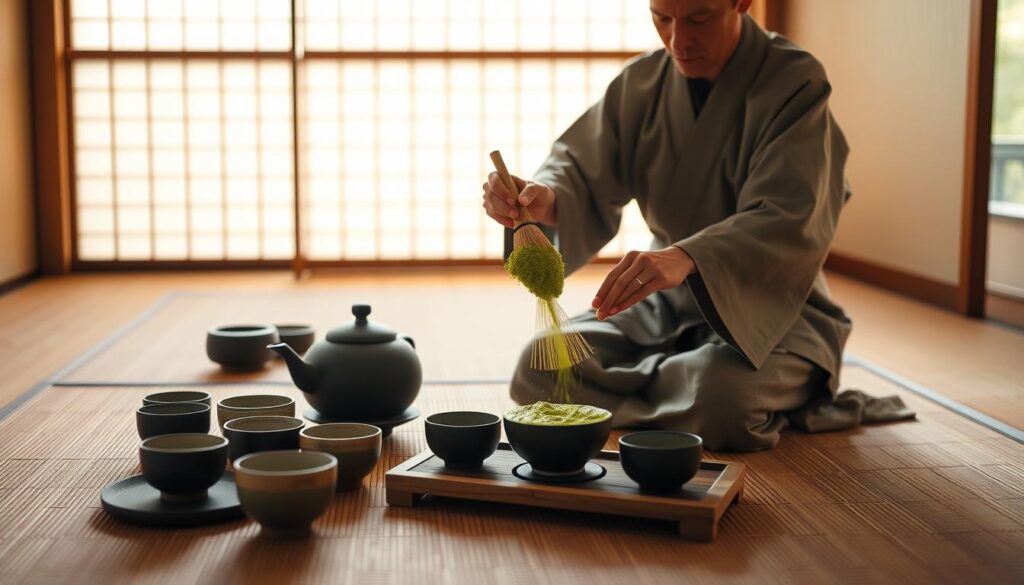

how to make green tea
Learning to brew green tea is more than just a skill. It’s about diving into the rich traditions of China and Japan. These cultures have perfected the art of making the perfect cup of tea.
Green tea brewing in China and Japan is not just about making tea. It’s about using special tools and following precise steps. This turns tea drinking into a beautiful art form.
- Japanese Kyusu ceramic teapots
- Chinese Gaiwan brewing vessels
- Ceremonial tea preparation techniques
In Japan, making green tea is all about being precise and mindful. Their traditional method includes several steps:
- Select high-quality green tea leaves
- Use water at precise temperatures
- Steep for exact duration
- Pour with controlled movements
| Brewing Method | Origin | Key Characteristics |
|---|---|---|
| Kyusu Method | Japan | Side-handled ceramic pot, short steeping time |
| Gaiwan Method | China | Multiple short infusions, delicate handling |
These traditional methods might seem complex. But they offer a deeper appreciation for green tea. By practicing these techniques, you’ll improve your green tea brewing skills at home.
Flavor Enhancement Options
When you make green tea, you can make it taste better with fun and tasty extras. By trying different ways to add flavor, you can turn simple green tea into a special drink. It will taste great and still be good for you.
Natural Sweeteners
Natural sweeteners can make your green tea even better without making it too sweet. Here are some good choices:
- Honey: Adds a sweet taste and more antioxidants
- Stevia: A sweetener with no calories, made from plants
- Maple syrup: Gives a deep, earthy flavor
- Agave nectar: Has a smooth, sweet taste
Complementary Ingredients
Adding certain ingredients can make your green tea taste better and be healthier. Here are some great options:
- Fresh lemon slice: Adds a bright taste and vitamin C
- Ginger root: Gives a warm taste and helps with digestion
- Mint leaves: Adds a cool, refreshing touch
- Cinnamon stick: Adds a subtle spicy flavor
Herbal Additions
Try adding herbs to your green tea for a new taste. Some great choices are:
- Jasmine blossoms: Adds a delicate floral taste
- Lavender: Makes it calming and aromatic
- Rosehip: Gives a tangy, fruity flavor
- Chamomile: Makes it soothing and mild
Remember, when adding flavor to green tea, start small. Add a little bit at a time until it tastes just right to you.
Hot vs Cold Brewing Methods
Exploring the best way to make green tea means learning about different brewing methods. Hot and cold brewing offer unique experiences. Each method affects flavor, aroma, and nutritional benefits differently.
Hot brewing is the traditional way to make green tea. It quickly pulls out flavors and releases the tea’s delicate compounds. Use water at 160-180°F, steep for 1-3 minutes to get the tea’s essence without bitterness.
Cold Brewing Green Tea: A Smooth Alternative
Cold brewing is a new way to make green tea. This method involves:
- Steeping tea leaves in cold water for 3-10 hours
- Creating a smoother, less bitter beverage
- Preserving more delicate antioxidants
Cold brewing has many benefits for green tea fans. Reduced bitterness and a milder flavor make it great for summer or those who prefer less strong tea.
Comparing Brewing Methods
| Brewing Method | Preparation Time | Flavor Profile |
|---|---|---|
| Hot Brewing | 3-5 minutes | Robust, traditional |
| Cold Brewing | 3-10 hours | Smooth, subtle |
Trying both hot and cold green tea brewing lets you find your favorite. Whether you like a quick hot cup or a cool brew, green tea fits every taste.
Common Brewing Mistakes to Avoid
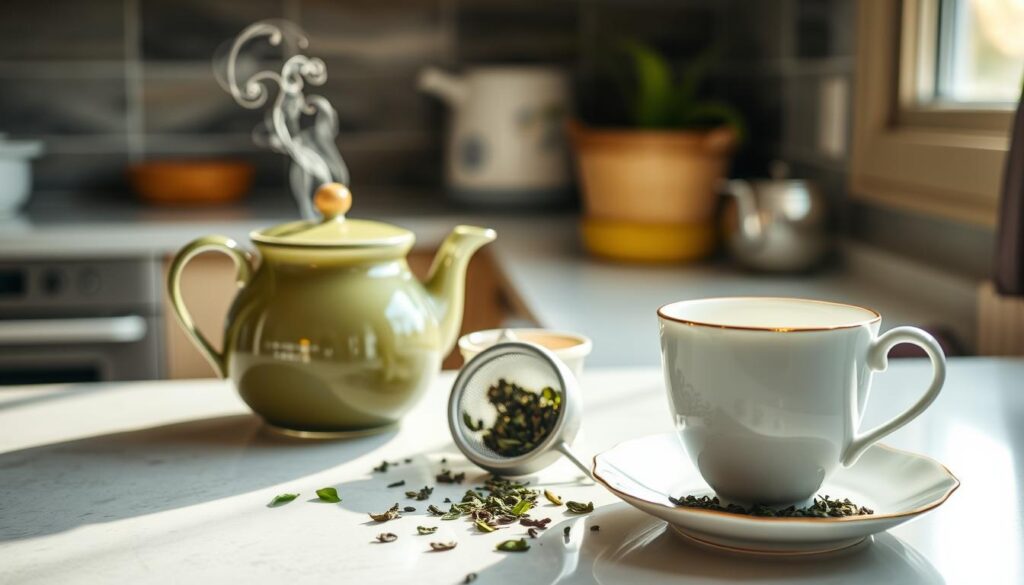

how to make green tea
Learning to brew green tea well means knowing the common mistakes. Many people unknowingly ruin their green tea by making simple errors. These mistakes can change the taste and health benefits of the tea.
Temperature control is key when brewing green tea. Pouring boiling water on green tea leaves can ruin it. The hot water burns the leaves, making the tea taste bitter and harsh.
- Water Temperature: Always use water between 160-180°F for optimal green tea extraction
- Steeping Time: Limit brewing to 2-3 minutes to prevent bitterness
- Leaf Quality: Select fresh, high-grade loose leaf tea for best results
Another mistake is steeping green tea too long. Green tea leaves release tannins fast, making the tea bitter if steeped too long. Use a timer to keep the brewing time right.
“The art of brewing green tea lies in delicate balance and mindful preparation.” – Tea Master wisdom
Water quality also affects your tea’s taste. Don’t use tap water with lots of minerals or chlorine. Instead, use filtered or spring water for the best taste.
By avoiding these mistakes, you can make your green tea experience much better. You’ll get to enjoy the full flavor and health benefits of this amazing drink.
Storage and Preservation Tips
Storing green tea right is key to keeping its taste and health benefits. The way you store it greatly affects its quality and taste.
Knowing how to store green tea is vital when you’re brewing it. Green tea is very sensitive to things that can make it go bad fast.
Protecting Your Green Tea’s Freshness
To keep your green tea fresh, follow these important storage tips:
- Store in opaque, airtight containers
- Keep away from direct sunlight
- Avoid moisture and humidity
- Maintain consistent cool temperatures
Ideal Storage Environments
The best place to store green tea stops it from getting old and keeps its green color. Ceramic or dark glass containers are best for protecting your tea leaves. But, be careful with the fridge because it needs the right humidity.
Shelf Life Considerations
Green tea stays at its best for 6-12 months if stored right. Signs it’s gone bad include:
- Loss of vibrant green color
- Stale or flat aroma
- Diminished flavor complexity
By using these storage tips, your green tea will stay fresh, tasty, and ready to drink anytime.
Seasonal Serving Suggestions
Learning to make green tea means knowing how to change your recipe with the seasons. Each season brings new ways to enjoy this versatile drink.
Summer is the time for cool, refreshing green tea drinks. Try these:
- Green tea lemonade with fresh mint leaves
- Iced green tea with cucumber slices
- Tropical green tea smoothie with pineapple
Winter is for warm, comforting green tea recipes. Try adding warming ingredients like:
- Cinnamon stick infusions
- Ginger and honey green tea
- Cardamom-spiced green tea blend
Spring and autumn are great for lighter, more delicate green teas. These seasons are perfect for brewing techniques that show off the tea’s subtle flavors.
“The art of green tea is not just in brewing, but in adapting to the rhythm of seasons.” – Tea Master’s Wisdom
Your green tea recipe can change with the seasons and your mood. Keep your brewing flexible to try new tastes all year.
Conclusion (how to make green tea)
Learning to make green tea is more than a skill. It’s a journey into a rich cultural tradition. It changes how you enjoy your daily drink.
The best way to make green tea is to understand its preparation. This includes choosing quality leaves and getting the water temperature right. You also need to know how long to steep it.
Exploring different brewing techniques makes each cup of green tea unique. You’ll learn to create a tea ritual that pleases your taste buds and boosts your health. The art of making green tea lets you enjoy its full flavor and health benefits.
As you try out different green teas and brewing methods, remember that practice is key. Your taste will get better, and you’ll know how to make the perfect cup of green tea. Enjoy the journey of becoming a true green tea lover.
Begin your green tea adventure today. Each cup is a chance to improve your technique. It’s a way to celebrate a timeless drink that connects you to centuries of tradition and wellness.
FAQ
What are the main types of green tea?
How much caffeine is in green tea?
What are the primary health benefits of green tea?
What is the ideal water temperature for brewing green tea?
How long should I steep green tea?
What’s the difference between loose leaf and tea bags?
Can I reuse green tea leaves?
How should I store green tea?
Can I add sweeteners to green tea?
Is cold brew green tea different from hot green tea?
There are no reviews yet. Be the first one to write one.

